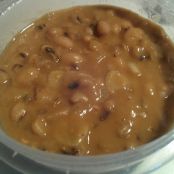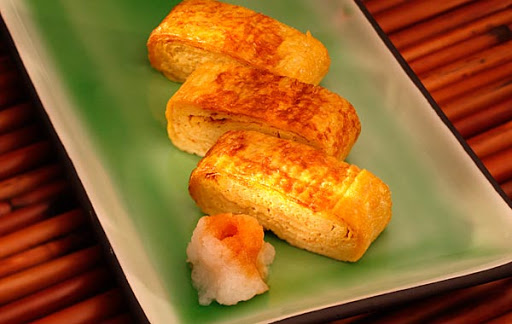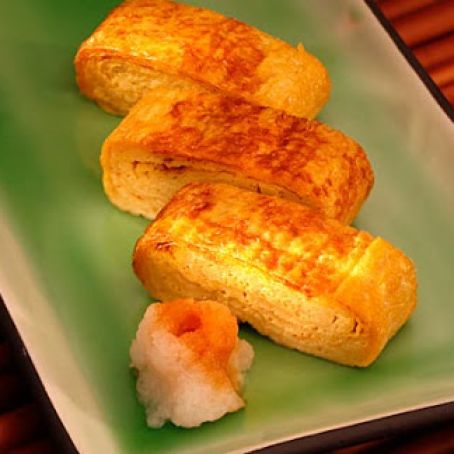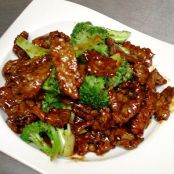Dashi-Maki Tamago (Japanese Egg Omelet)
Konbu (dried seaweed), dried bonito flakes and light soy sauce can be found at Japanese markets. Tamago frying pans are available at Japanese markets, but you can use a round 10-inch nonstick frying pan. This recipe calls for a bamboo sushi mat, available at Japanese stores.
From LA Times.
Ingredients
- DASHI:
- 1 1 to 8 konbu (6 to 8 inches long)
- 4 4 4 cups water
- 2 2 2 cups dried bonito flakes (katsuo-bushi)
- TAMANGO:
- 6 6 6 eggs
- 3 3 3 teaspoons sugar
- 3 3 3 teaspoons light soy sauce (usukuchi shoyu)
- 1/4 1/4 2 cup plus 2 tablespoons dashi
- 2 oil for frying (about 2 tablespoons)
- 1/2 1/2 1/2 cup grated daikon radish (to serve on the side)
- Soy sauce
Details
Servings 4
Cooking time 75mins
Adapted from latimes.com
Preparation
Step 1
Dashi:
Using scissors, make several crosswise slits in the konbu (this helps to extract the flavor during cooking). In a medium saucepan, combine the konbu and water and set aside for 15 minutes. Place the pan over medium heat until the water almost comes to a boil, about 5 minutes. Remove from heat.
Cool the mixture for a couple of minutes, then gently add the bonito flakes (do not stir them into the mixture). After 5 minutes (the bonito flakes will have settled to the bottom of the pan), strain the dashi through a very fine mesh sieve, or a sieve lined with cheesecloth. This makes about 3 cups dashi, more than is needed for the remainder of the recipe. The dashi will keep, covered and refrigerated, for 3 to 4 days. Do not stir the dashi as this will cloud it; it should have a light golden color.
Tamago:
In a large bowl, gently mix together the eggs, sugar, soy sauce and dashi. Do not whisk the ingredients too vigorously. Gently pour the mixture in a large measuring cup.
Heat a 10-inch nonstick pan or a tamago pan over medium-high heat. Add about a tablespoon of vegetable oil, spreading the oil evenly. Wipe away any excess oil with a paper towel, leaving just a thin film on the bottom of the pan.
Test the pan with a little egg. It should sizzle. Try to keep the pan at this temperature while cooking the eggs. Pour one-sixth (about one-fourth cup) of the egg mixture into the pan and distribute it quickly and evenly around the entire pan, tilting the pan back and forth. When the tamago starts to bubble, use the tip of a chopstick, knife or skewer to break any air bubbles. When the tamago is set on top and nearly cooked through, use chopsticks or a spatula to quickly roll the tamago toward you in thirds, as if folding a letter. (The first roll is the hardest. The egg might tear, but it will be covered by other layers of the egg mixture.) Keep the first roll off to one side of the pan as you proceed.
Baste the pan with more oil, using a paper towel to remove any excess oil. Pour another one-sixth of the egg mixture into the pan for the second roll, lifting the first roll and spreading the egg mixture under it. When the tamago is nearly cooked, roll the omelet over the first roll, again as if folding a letter into thirds.
Remove any loose egg particles from the pan with the paper towel. Add more egg mixture and repeat, rolling into thirds until you have used up all the egg. Brown the surface of the completed tamago.
Wrap the tamago loosely in a bamboo sushi mat to give the tamago some shape. The tamago has a lot of dashi inside so don't squeeze it. Let the tamago rest for a couple of minutes wrapped in the mat.
Remove the tamago from the mat and slice it crosswise into 1-inch pieces. Serve with grated daikon radish and soy sauce. Tamago is best served hot, though it can also be enjoyed at room temperature.
You'll also love
-
 Spinach, Feta, & Sun-Dried Tomato...
4.7/5
(25 Votes)
Spinach, Feta, & Sun-Dried Tomato...
4.7/5
(25 Votes)
-
 Basic Black-Eyed Peas
4.4/5
(12 Votes)
Basic Black-Eyed Peas
4.4/5
(12 Votes)
-
 Greek Spaghetti
4.4/5
(13 Votes)
Greek Spaghetti
4.4/5
(13 Votes)
-
 Blueberry Sour Cream Waffles
4.2/5
(13 Votes)
Blueberry Sour Cream Waffles
4.2/5
(13 Votes)
-
 Slow-Cooker Chana Masala
4.1/5
(32 Votes)
Slow-Cooker Chana Masala
4.1/5
(32 Votes)
-
 German Apple Pancake
4.4/5
(9 Votes)
German Apple Pancake
4.4/5
(9 Votes)
-
 Loaded Chicken Fajita Omelette
4/5
(2 Votes)
Loaded Chicken Fajita Omelette
4/5
(2 Votes)




Review this recipe